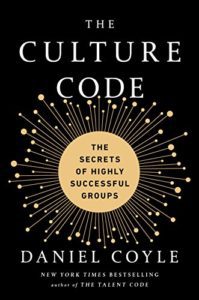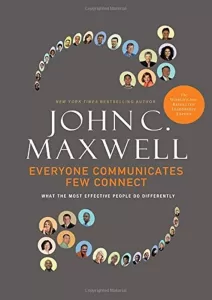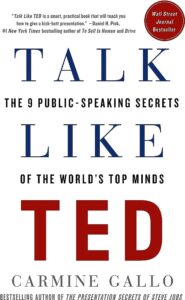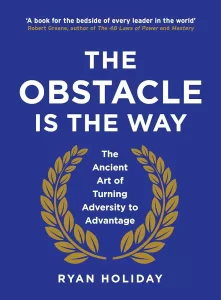Book Review: “The Culture Code”
Book: The Culture Code by Daniel Coyle
Reviewer: Bobby Powers
My Thoughts: 8 of 10
Coyle spent four years researching what causes teams to be successful. Along the way, he studied groups as diverse as the Navy SEALs, the San Antonio Spurs, and a gang of jewel thieves. I loved this book because it provides dozens of examples of what types of cultural norms keep teams together. It's loaded with fascinating anecdotes and team values from dozens of organizations. Some of my favorites were "Be aware of your emotional wake," "Put us out of business with your generosity," and "B-level work is bad for your soul." This book is especially useful for culture builders looking to further crystallize your company's unique values.
Selected Quotes and Ideas from the Book
Overarching Concepts
- “Group culture is one of the most powerful forces on the planet. We sense its presence inside successful businesses, championship teams, and thriving families, and we sense when it’s absent or toxic. We can measure its impact on the bottom line. (A strong culture increases net income 765 percent over ten years, according to a Harvard study of more than two hundred companies.) Yet the inner workings of culture remain mysterious.”
- Coyle found that strong organizational culture is driven by three specific things:
- Strong teams find ways to build safety.
- Strong teams share vulnerability with each other.
- Strong teams establish purpose and every member commits to that purpose.
(1) Build Safety
- “Cohesion happens not when members of a group are smarter but when they are lit up by clear, steady signals of safe connection.”
- MIT researcher Alex Pentland conducted studies that show team performance is driven by five measurable factors:
- Everyone in the group talks and listens in roughly equal measure, keeping contributions short.
- Members maintain high levels of eye contact, and their conversations and gestures are energetic.
- Members communicate directly with one another, not just with the team leader.
- Members carry on back-channel or side conversations within the team.
- Members periodically break, go exploring outside the team, and bring information back to share with the others.
- “It’s important to avoid interruptions. The smoothness of turn taking, as we’ve seen, is a powerful indicator of cohesive group performance. Interruptions shatter the smooth interactions at the core of belonging...The key is to draw a distinction between interruptions born of mutual excitement and those rooted in lack of awareness and connection.”
- “One misconception about highly successful cultures is that they are happy, lighthearted places. This is mostly not the case. They are energized and engaged, but at their core their members are oriented less around achieving happiness than around solving hard problems together.”
- “[Larry Page’s] main leadership technique, if it could be called a technique, consisted of starting and sustaining big, energetic, no-holds-barred debates about how to build the best strategies, products, and ideas. To work at Google was to enter a giant, continuous wrestling match in which no person was considered above the fray.”
(2) Share Vulnerability
- “Exchanges of vulnerability, which we naturally tend to avoid, are the pathway through which trusting cooperation is built.”
- “Vulnerability doesn’t come after trust--it precedes it. Leaping into the unknown, when done alongside others, causes the solid ground of trust to materialize beneath our feet.”
- “Most of us instinctively see vulnerability as a condition to be hidden. But science shows that when it comes to creating cooperation, vulnerability is not a risk but a psychological requirement.”
- “Make sure the leader is vulnerable first and often...group cooperation is created by small, frequently repeated moments of vulnerability. Of these, none carries more power than the moment when a leader signals vulnerability.”
- After-Action Reviews (AARs) in the Navy SEALs "happen immediately after each mission and consist of a short meeting in which the team gathers to discuss and replay key decisions. AARs are led not by commanders but by enlisted men. There are no agendas, and no minutes are kept. The goal is to create a flat landscape without rank, where people can figure out what really happened and talk about mistakes--especially their own. ‘It’s got to be safe to talk,’ (Dave) Cooper says. ‘Rank switched off, humility switched on. You’re looking for that moment where people can say, “I screwed that up.” In fact, I’d say those might be the most important four words any leader can say: I screwed that up.’”
(3) Establish Purpose
- “Walking around these [high-performing organizations], you tend to hear the same catchphrases and mottos delivered in the same rhythms...These groups, who by all rights should know what they stand for, devote a surprising amount of time telling their own story, reminding each other precisely what they stand for--then repeating it ad infinitum.”
- “[Establishing purpose] is not as simple as carving a mission statement in granite or encouraging everyone to recite from a hymnal of catchphrases. It’s a never-ending process of trying, failing, reflecting, and above all, learning.”
- “A while back Inc. magazine asked executives at six hundred companies to estimate the percentage of their workforce who could name the company’s top three priorities. The executives predicted that 64 percent would be able to name them. When Inc. asked employees to name the priorities, only 2 percent could do so. This is the not the exception but the rule. Leaders are inherently biased to presume that everyone in the group sees things as they do, when in fact they don’t. This is why it’s necessary to drastically over-communicate priorities.”
Think you’d like this book?
Other books you may enjoy:
Creativity, Inc. by Ed Catmull with Amy Wallace
Work Rules! by Laszlo Bock
No Rules Rules by Reed Hastings and Erin Meyer
Other notable books by the author:
The Talent Code by Daniel Coyle
The Secret Race by Tyler Hamilton and Daniel Coyle
Lance Armstrong's War by Daniel Coyle







Hey Bobby, It’s Matt Hutson here from BookMattic,
I’ve also got this book on my shelf waiting to read. I love all the points in your review. It seems like the takeaways can also easily be applied in any group or business. I will for sure read The Culture Code before the year is up.
Thanks for checking out my site, Matt! I’m really glad you enjoyed the book, and please let me know what you think once you finish it.
What have been your favorite couple personal development books this year?